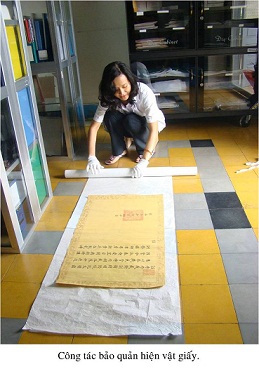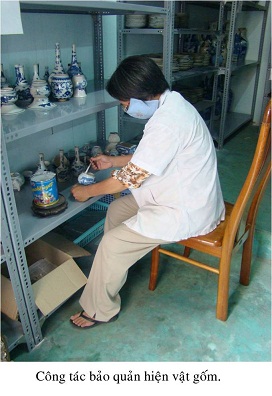The inventory and preservation of artifacts is one of the key tasks of the museum. Ho Chi Minh City Museum is currently storing and preserving 45,666 artifacts, divided into 133 thematic collections, including 14 rare and precious collections with various materials such as ceramics, terracotta, and terracotta. , metal, woodwork, paper, cloth, plastic, horn bone, ivory… belonging to different historical periods, meeting most of the needs of scientific research and display work.
Rare collections:
– Flag
– Administrative documents
– Radio, camera
– Wooden
– Statue of folk worship
– Artifacts related to historical figures
– Weapons
– Sketches of the resistance
– Cochinchinese zinc coins in the 18th century
– Silver coins (from the middle of the XVIII century – the middle of the XX century)
– Bonuses – Large denominations (from the middle of the XVIII century – the middle of the XX century)
– Indochinese metal coins
– Mold for printing VNDCCH banknotes ONLY
– Finance Department of the Central Department of the Southern Department

Artifacts of the Ho Chi Minh City Museum come from different sources: an inherent part of Gia Long Palace; partly donated by collaborators and people; partly transferred by the police and customs agencies; another part is acquired by some collectors. Especially in recent years, with the attention and consent of the People’s Committee of Ho Chi Minh City and the Board of Directors of the Department of Culture, Sports and Tourism, the City Museum has also collected some a large number of artifacts of historical and cultural value, including rare collections.
Collecting artifacts of feudal coins :
– Collection of bonuses, silver coins, money of large denominations : under the autocratic monarchy spanning more than 3 centuries, from the reign of Le Canh Hung (1740 – 1786); Tay Son (Canh Thinh 1793 – 1802); until the Nguyen Dynasty (1802 – 1819), Minh Mang (1820 – 1840), Thieu Tri (1841 – 1847), Tu Duc (1848 – 1884), Thanh Thai (1889 – 1907), Khai Dinh (1916 – 1925), Bao Dai (1926 – 1945). With more than 200 artifacts are original artifacts, very good quality.
– Inner zinc coin collection: dating from the 17th century to the 19th century. This is a collection of Dang Trong zinc coins spanning more than 3 centuries, from the Nguyen Lords dating from the 17th century, the Tay Son dynasties (the second half of the 18th century), to the Nguyen Dynasty in the 19th century, and a number of brands. Chinese coins were minted in Cochinchina. This is a relatively complete collection, the quality of money is still very good, especially these are the original, used artifacts related to the economic trade and exchange of Saigon – Gia Dinh – the old South, copper. The period contributed to reflecting the minting technique, the development of commodity economy from the 17th century to the second half of the 19th century. The collection is valuable in terms of culture, historical development of Vietnamese currency in general and Saigon – Gia Dinh – Southern currency in particular.
But unique and impossible not to mention is the collection of silver shuttlecocks recorded quite clearly by the history books of the Nguyen Dynasty.
Collection of seals (seals) :In addition to the bronze seal “Ta Quan chi seal” of the Governor General of Gia Dinh – Left Army Le Van Duyet has been collected since 2001, Ho Chi Minh City Museum has just collected a number of bronze and ivory seals. The collection of feudal seals dates from the 15th century to the early 20th century, specifically from the late Ho (1407), Le So (1428 – 1527) to Tay Son (1778 – 1802) and Nguyen dynasties. (1802 – 1945), there are many artifacts associated with important periods in Vietnam’s history from the Le Dynasty (Le Thanh Tong) to the Tay Son Dynasty Nguyen Hue, associated with the heroic victory of Rach Gam – Mango mango. (1785), Ngoc Hoi – Dong Da victory in the year of the Rooster (1789), associated with characters related to the history of the land of Saigon – Gia Dinh: Tran Van Nang, Le Tuan… are particularly precious artifacts. rare. This seal collection helps historians,
Collection of ancient administrative documents: including hundreds of artifacts are administrative documents. These are original artifacts, including Han-Nom documents with seals of Kings and Quans under the Nguyen Lords, Nguyen Dynasty, are quite unique and rare documents, it marks a period of formation. formation and development of the Southern region; related to the character’s history in the land of Saigon – Gia Dinh (for example, about the character Tran Van Thanh, who lived in Tan Thanh village, canton Tan Long, Tan Binh district, Gia Dinh government was about to be an official under Lord Nguyen Dynasty) and Nguyen Dynasty). These documents also contribute to the study of administrative geography in Gia Dinh, research on the hierarchy and titles of mandarins; Forms and regulations for sealing seals in the Nguyen and Nguyen dynasties. There are also Han-Nom, French and Vietnamese texts in the late nineteenth century,

Collection of documents, texts, books of resistance :Belonging to the period of resistance wars against France and the US until the early years of the liberation of the South (from 1945 to 1978), in which there is a group of Tien Phong artifacts… including books, newspapers, internal magazines, leaflets, letters, In this collection, there are documents such as: book Constitution of the Democratic Republic of Vietnam released by Gia Dinh Provincial Propaganda Department in 1946, book “Le procè de la Coloníation” Francaise” (the verdict of the colonial regime), author Nguyen Ai Quoc, Hanoi Vietnam National Press Office printed in 1946, or the camouflage books and leaflets of the Tien Phong Youth… are the original documents. precious and rare for the study of Vietnamese history in general and the history of Saigon – Gia Dinh in particular in the early days of liberation under the military rule.In this collection, it is impossible not to mention the collection of documents of the Central Finance Department of the Southern Department.
Collection of ceramic artifacts: The land of Saigon – Ho Chi Minh City is the place where the pottery profession was formed and developed simultaneously with the process of exploring the new land of the South from the 17th century to the 18th century. In order to preserve and preserve the heritages associated with this southern land, the City Museum has also collected and preserved a large number of artifacts of Saigon pottery, Lai Thieu pottery, Bien Hoa… The typical collection of ceramic artifacts is a collection of ceramic folk worshiping statues that are valuable in terms of history, culture and beliefs of the Vietnamese people in the land of Saigon – Ho Chi Minh City in particular and the land of South Vietnam. In particular, it must be mentioned that the statue is decorated on the roof of a temple located on Tran Van Kieu Street, Ho Chi Minh City. These are ceramic products for religious architecture in temples, The Chinese Assembly Hall in Ho Chi Minh City is quite diverse and unique; Art and technique show the unique features of the Hoa Viet pottery line in Saigon – Cho Lon in the last decades of the 19th century and the beginning of the 20th century. This collection contributes to the study of pottery in old Saigon as well as cultural and religious nuances of the Chinese residents in the process of community and cultural exchange in the South.
Collection of archaeological artifacts : discovered through survey and excavation of archaeological relics such as: Ben Do site (dated from 3000-2500 years ago). Phu Hoa site, Giong Ca Vo archaeological site (dating 2500 to present day) Rong Bang site (dating 3000-2500 to present day), Hoi Son relic (dating from 3000-2500 to present day) , Giong Am site, Giong Ca Trang site, Giong Phet site (dated 2,100 years ago), Hung Loi pottery kiln, artifacts of some ancient tombs and other relics in the city. Some outstanding objects of this collection are: Earrings with 2 heads of animals, Grave of ceramic jars.
Collection of furniture artifacts : with nearly 1,400 artifacts, including folklore artifacts associated with the daily life of Vietnamese residents in the ancient southern land. Especially the artifacts of Gia Long Palace and related to two of the “Four Great Wealthy Families” in the South set out at the end of the 19th century and the beginning of the 20th century, associated with life in which the typical woodblock “Dai Nam Quoc full map” of ebony wood, embossed with Han Nom characters. Woodblocks show quite clearly and relatively fully the entire territory and territorial sea of Vietnam.
The printing mold for the Democratic Republic of Vietnam banknotes : Including the mold for printing bills of 5 dong denominations made by the Central Administrative Committee of the Resistance in accordance with the Decree 234/SL dated 18/7/1947 of the President of Democratic Vietnam. Republic; printing mold of 20 dong bill circulated in the South during the period 1948 – 1952, printed in sub-division A (Dong Thap Muoi); and a printing mold of 20 dong circulated in the Southern region during the period 1948-1952…

The Inventory and Preservation Department regularly provides content, images, and artifacts for thematic and permanent exhibitions at the museum as well as coordinates with the museums you carry out thematic exhibitions outside of the museum. Museum. Performing the essential task of the museum is preserving cultural heritages, and at the same time exploiting and promoting in the best way the value of the museum’s artifacts in order to educate and disseminate scientific knowledge to the public. general public.
Every year, many students, journalists, and scientific researchers come to the museum to exploit information and images for scientific research and write research articles. In recent years, in order to try the museum’s professional work and socialization activities, with a team of experienced inventory and preservation staff. The Inventory and Preservation Department regularly performs a number of contracts related to the preparation of scientific records, preservation and restoration of exhibits for a number of monuments and museums in the city and of a number of others. conscious.
